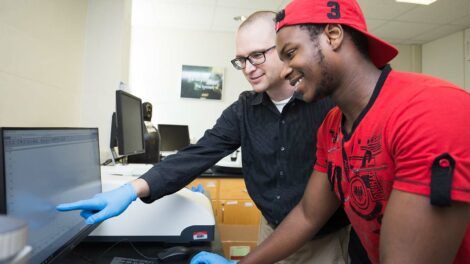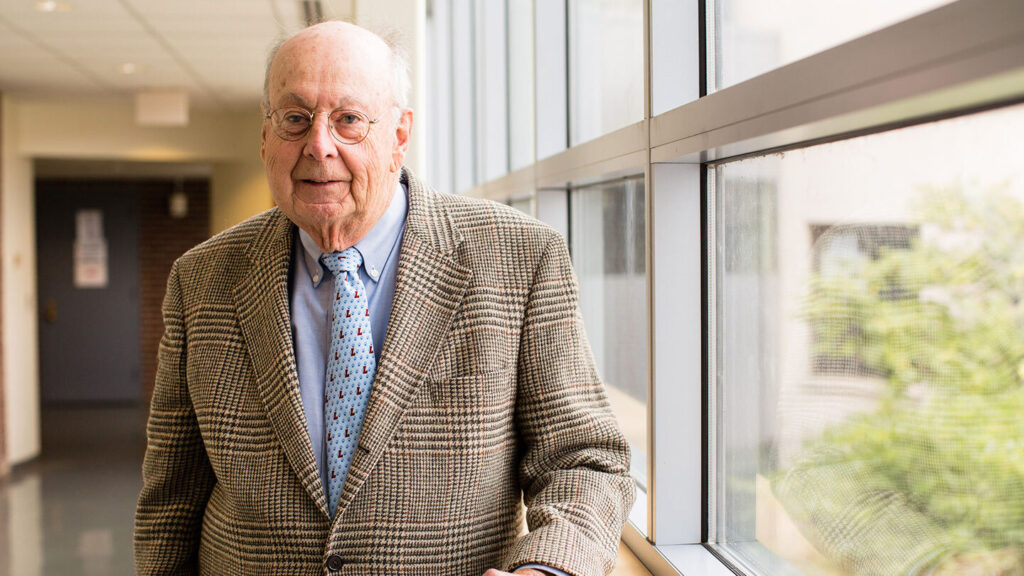Make an Impact

Support Lafayette Engineering
Your support will enable the College to make an even greater difference for the future
Scott, who received financial and academic support as a student, is passionate about contributing to the next generation's success

Walter Scott ’59 earlier this year endowed a chair for the new Integrative Engineering program at Lafayette College.
By Bryan Hay
Across more than six decades between the two degrees he earned at Lafayette College, Walter Scott ’59 clearly enjoys any time spent reflecting on his lifetime association with his beloved alma mater.
Speaking from his home in South Londonderry, Vt., he says he’s been pondering what it means to have received an honorary doctor of humane letters degree during the College’s 187th Commencement in May.
“I’ve been active in the school’s affairs for about 35 years, and I have enjoyed every minute of it,” he says. “But the recognition was very moving. And I have a great love for Lafayette.”
Scott’s support of scholarship and student success is reflected across Lafayette College. He served as a Lafayette trustee from 1988 to 2006, when he retired from the board and was elected trustee emeritus. He served as chairman of the board’s committee on financial policy from 1991 to 2001 and from 2004 to 2006.
Over many years, Scott and his late wife, Kate, made several significant, generous gifts to support academic initiatives, including faculty awards, endowed scholarships, endowed faculty positions, faculty research, and infrastructure for academic programs.
This year, he endowed the Walter Scott Chair of Integrative Engineering, advancing and supporting the new degree program that offers the opportunity to study emerging and interdisciplinary fields of engineering. His gift also supports the expansion at Acopian Engineering Center. Now under construction on the east side of Acopian, the 4,000-square-foot Scott Pavilion on the fifth floor will add three high-tech classrooms and a glass collaboration center.
In 1996, Scott established the annual Marquis Distinguished Teaching Awards to underscore the importance of and reward superior teaching, which he says is the cornerstone of a Lafayette education. And he made a gift to save and extensively renovate Scott Hall, named in memory of his parents, Ruth Hawkins Scott and Charles Lukens Scott. The gift also endowed a scholarship fund that provides financial assistance to Marquis Scholars.
Scott’s affection for Lafayette runs deep.
“I feel that much of my success in life is directly attributable to what Lafayette did for me,” Scott says. “And I feel it’s essential to give back.”
Scott grew up in a low-to-middle-income family in Wilson Borough, not far from Lafayette, graduating from Wilson High School with an interest in pursuing civil engineering. Lafayette was his third choice behind Penn State and Lehigh.
“I desperately wanted to get out of the area and go away to school like most kids do,” Scott recalls. “But, at that time, room and board at Penn State was almost as much as its tuition, and I couldn’t afford that. And if I had gone to Lehigh, which offered a partial scholarship, I would have needed a car to get there, and I couldn’t afford that.”
So, Scott chose Lafayette out of financial necessity, which awarded him a half-tuition scholarship. Lafayette was also the choice of some of his Wilson High School friends, so he hitched rides with them to campus.
“We all had 8 a.m. classes, and the day didn’t end until around 3:30 or 4:30 in the afternoon, every day of the week, and a half day on Saturday,” he says, adding that ROTC was required in the 1950s for the first two years, along with rigorous lab instruction. “It was rare if I got to bed before 1 in the morning.”
“A pivotal thing that happened in my freshman year was an English professor who noticed that I was having problems with reading and keeping pace with the demands of the English courses,” Scott says. “I was a desperately slow reader, which I still am to this day.”
Scott received the help he needed through a remedial reading course, taught by Clay Ketcham, the first female professor at Lafayette. This experience motivated Scott to support the renovation of what is today Scott Hall, which houses the Academic Resource Hub, where students can receive help with their academic studies.

Walter Scott, 1959 Melange yearbook.
He did well enough at Lafayette to consider a career in academia and was accepted with a fellowship into the graduate program at University of Illinois, a top civil engineering school.
Scott began comparing Lafayette, where he was one of a dozen civil engineers in his class, to a university with 1,000 or more graduate and undergraduate civil engineers and began feeling overwhelmed.
“It didn’t take me long, once I got there, to realize that I got a superior education at Lafayette,” he says. “The undergraduates out there were taught by people like me, and they couldn’t write or express themselves. That’s when I began to get a real appreciation of what Lafayette had done for me while I was there.”
Originally sold on becoming a college professor, Scott says he grew tired of large university politics, and he didn’t like being poor, so he switched gears and applied to the graduate business school at Yale, figuring it would be a smoother path to career satisfaction and financial independence.
After Yale, just as computers were entering the business world in the early 1960s, he went to work for Air Products and Chemicals Inc. to do computer modeling, both on technical processes and in business problems.
After Air Products, he spent a brief time in the furniture industry before working in divestitures and raw material acquisitions at the former Jones and Laughlin Steel Co. in Pittsburgh, once one of the largest integrated steel companies in the United States.
By that time, his business instincts sharpened, he predicted the grim outlook for the steel industry and went to work for American Can Co., which owned the Dixie Cup plant in his hometown of Wilson Borough.
Scott’s mother had taken a job at Dixie Cup to support the family after his father, a draftsman for Ingersoll Rand Inc., died between his junior and senior years at Lafayette.
At American Can, Scott became one of the few senior executives who transitioned from making tin cans to managing financial services for the company. Scott still remembers the beaming pride expressed by his mom when she received her first pension check with his signature, as company controller, on the bottom.
Scott ended his career running ACE as its 21st employee, which, at the time, was a small startup insurance company in Bermuda. He started the company’s diversification program, made a significant acquisition, and took ACE public. That company is now the largest publicly traded property and casualty company, trading as Chubb today.
After retiring as its CEO, he continued on the company’s board and subsequently became the chairman of a publicly traded credit enhancement company, which has the distinction of being the only one that was capable of trading through the financial crisis of 2009.
“The flexibility to change careers and adapt to new situations and to learn new industries, I directly attribute that to the liberal arts I was exposed to at Lafayette,” Scott says.
Scott’s older brother, Martin Scott ’55, also received financial support from Lafayette, earned a chemistry degree, and worked his entire career at Eastman Kodak Co. The Scott brothers were both first-generation students.
“Nobody in our family had ever gone to college before,” Scott says. “We were not in an economic position to be able to pay even the minimal kind of tuition being charged back then. But our parents made sacrifices so that we could go to school, following that old traditional ethic about working hard to make a better life for your children. They believed in that.”
Looking back to the Lafayette campus Scott and his brother knew as students, he says much has changed and much has remained unchanged.
“Even the liberal arts students were taking a minimum of five courses back then. Engineers had a lot more courses,” he says. “We didn’t have health centers. We didn’t have nice gyms with rock climbing. It was all male. And more than 50% of the students belonged to fraternities because that’s where the beds were, and that’s where the food service was.”
But the commitment of faculty and the time spent with the students was, and still is today, “absolutely outstanding,” he notes. “That’s what makes Lafayette so special. Lafayette is totally focused on undergraduate education.”
Another generation of the Scott family is also making its way through Lafayette.
His granddaughter, Samantha Scott ’22, is following family tradition, loving every moment of her Lafayette experience so much that she’s sharing it with prospective students.
“This coming fall, she’s going to be interviewing prospective students and helping in admissions,” Scott says. “For the last several years, she has worked on introducing incoming freshmen to Lafayette. She really loves the school and is very active, even more so than I had been.”
Asked for his views on why alumni should support Lafayette, Scott notes the importance of having solid rankings in U.S. News & World Report and The Princeton Review.
“The percentage of alumni contributing annually to their alma mater is a key measure these publications use to measure alumni satisfaction of the education they received,” he says. Scott thinks Lafayette’s percentage should be higher and cites that as a reason why it isn’t ranked higher.
“And it doesn’t make any difference whether you’re giving 50 bucks or 5,000 bucks. It’s a numbers game,” Scott adds. “When your school has a good reputation, your diploma is worth more. I think there should be an appeal to at least give something back, and we need to reach different groups, like international students.”
“It all goes back to what I was talking about—the importance of attending a smaller, more intimate institution that’s totally committed to undergraduate education,” Scott says. “With the Rockwell Integrated Sciences Center and the changes we’ve made in engineering, you will get a superior education here because our facilities are great, and our academic leaders are terrific.
“And in addition to that, no matter what discipline you pursue, you get exposure to the liberal arts, which, in the long run, gives you the flexibility to make career changes,” he adds. “Most kids entering college don’t know what they want to do, and even the ones who do think they know what they want to do frequently change their mind as their lives progress. We need an institution where you get the skills to learn and adapt.
“But Lafayette is fortunate enough, with its endowment, to have the resources to really provide the faculty and facilities to deliver a superior education,” Scott says.

Your support will enable the College to make an even greater difference for the future
1 Comment
Every great college is great in her own backyard. Walter Scott helped make that true, and remains an enrollment manager’s dream alumnus. Thank you, and best wishes, Walter.
Comments are closed.